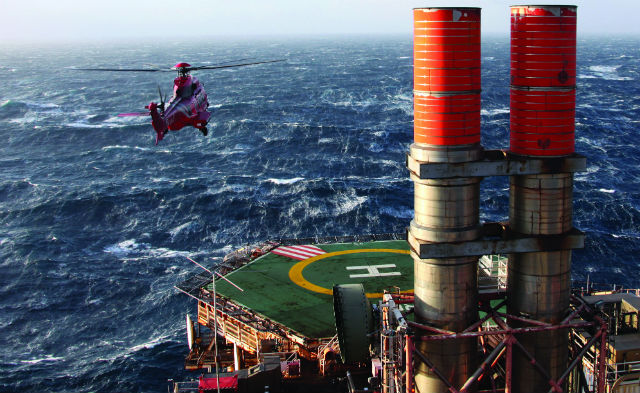Offshore helicopter operators have clearly been hurt by events over the past few years. A series of accidents – mostly but not exclusively on the UK side of the North Sea – that culminated in the August 2013 fatal crash of a CHC Scotia-operated Super Puma near Shetland have led to unprecedented scrutiny of the sector’s safety record.
Aside from the regular accident investigations and fatal accident inquiries in the courts, UK regulator the Civil Aviation Authority (CAA), as well as politicians, have weighed in with separate reports into offshore helicopter safety.
The industry has not stood still, however. In the wake of the Shetland accident, the North Sea’s big three – Avincis (parent of Bond Offshore Helicopters), Bristow Group and CHC Helicopter – came together to launch the Joint Operators Review (JOR), which aimed to drive safety improvement through sharing best practice.
But now the industry’s ambitions have grown. A new global safety organisation called Heli Offshore is to formally launch later this month. Its founder members include the three operators mentioned above, plus fellow US firms PHI and Era Group. In all, around 80% of the global offshore fleet is accounted for by the five companies.
Based in London, Heli Offshore will be led by Gretchen Haskins, an expert in human factors and former board member and safety director at the CAA and UK air navigation service provider NATS.
A small room inside a serviced office building in central London is the current home of the fledgling organisation. A rabbit warren of identical-looking corridors leads to its meeting room – signposted by a piece of printed A4 paper taped to the door. Inside, large photographs of the operators’ helicopters decorate the walls, and on the window ledge there are several perspex plaques commemorating the occasion of the first board meeting, held on 18 September.
“It’s quite a special thing – the CEOs are putting aside competitiveness to join together on this. We wanted to mark the date of the first board meeting,” says Haskins.
Although the mundane business of ushering a non-for-profit limited company into being formed part of the discussions at the first meeting, the board also quickly got down to the task at hand. “The JOR workstreams are already up and running and we want to make sure we hit the ground running on the key safety priorities,” says Haskins.

Plans to tackle each of those priorities will be drawn up – addressing them not through what Haskins describes as “best endeavours”, but through “a clear, resourced plan with dates and deliverables” that will serve to “mobilise those five companies”. Previously the JOR relied on ad hoc resource from the three members.
The workstreams are those already developed by the JOR, dealing with automation, training, manufacturing, emergency response and safety information, with another focused on health and usage monitoring system (HUMS) data. “[HUMS] is built to be a safety tool – we need to make sure it gets used worldwide in the best possible way,” Haskins says.
The analysis of a huge amount of data drawn from HUMS, flight management systems and line-orientated safety audits will also form a core part of its work.
Although a global organisation, Heli Offshore’s intention is not to push for uniform regulation across every jurisdiction. However, says Haskins, if a country’s proposed rules appear inadequate, the industry now has a platform from which to raise questions and present dissenting views.
Heli Offshore’s core membership will be drawn from operators themselves, with other interested parties allowed to sign up as “client” or “alliance” members. This includes the four Western helicopter manufacturers – who Haskins is confident will join as it represents a “very valuable” opportunity “to hear from operators what would make the biggest difference to them”. Those travelling in the rear of the helicopters will also get a seat at the table, with trade unions also welcome to join.
Despite recent history, Haskins is a little equivocal when it comes to the question of whether or not offshore helicopters operators have a safety problem. “Compare it to walking across the street – well, it’s safer than that,” she says. “Compare it to commercial aviation and there’s some way to go. But we want to take on that challenge.”
One of the board’s goals, she says, is to ensure that the offshore accident rate is at least equal to, or ideally better than, that of the commercial aviation industry.
She also rejects a suggestion made by UK politicians that profit motives may be adversely affecting helicopter safety, noting that although the organisation “won’t ignore it” she has “not seen evidence” to support the allegation.
Haskins stresses that Heli Offshore is not there to police the industry. “I’m more into safety improvement and achieving those goals rather than holding someone’s feet to the fire,” she says. “The biggest safety advances come when people are working together to achieve those aims.”
This collaboration is perhaps the unique feature of Heli Offshore. Even if one operator believes their priorities are different, “they don’t change that much from one company to another, or even from one country to another”. And the huge “mobilisation” of resources across the companies will lead to “new ways of solving the problems”.
Haskins describes herself as “genuinely excited” by the “golden opportunity” presented by Heli Offshore and its “structured, clear remit to share, develop and implement best practice”.
“What I see from the CEOs is a real ownership of the issue and a commitment to the safety of the passengers and crew on their aircraft.
“Once you have that, you have what you need to drive consistently higher levels of safety,” she says.
Source: FlightGlobal.com























